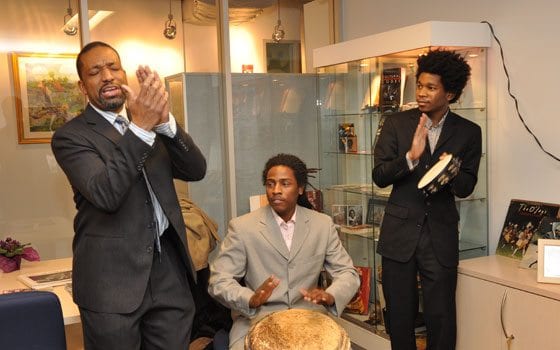
Born in New Orleans, the birthplace of jazz, Donald Harrison grew up steeped in jazz culture, dancing to traditional jazz and listening to the wealth of African American music played there.
But like many musicians in his generation, he came to Boston to learn how to play jazz.
It was the late ’70s and the popularity of jazz music had waned considerably. But here in Boston, Harrison found a wealth of talent in the classrooms at the Berklee College of Music, in jam sessions with fellow students and in the handful of clubs that catered to jazz fans.
“It was a very nurturing environment,” Harrison said during a visit to Berklee Monday. “There were a lot of young musicians who liked to play jazz. They are now among the foremost of those who are in jazz.”
While Harrison was sharing bandstands with Kevin Eubanks, Mavin “Smitty” Smith, Terrance Blanchard, Branford Marsalis and other rising stars in the jazz world, it was a memorable night at the South End jazz spot Lulu Whites that rocketed his career forward.
There on a night in 1980, Harrison met drummer and band leader Art Blakey, who for decades nurtured talented young musicians, putting them through the school of hard bops in his Jazz Messengers band.
Harrison’s meeting, facilitated by his teacher and former Messenger Bill Pierce, was no different.
“Art said, ‘Get your horn,’” Harrison recalled. “I, being scared, said ‘No.’ But he convinced me I had no choice in the matter.”
Harrison acquitted himself capably, judging from Blakey’s parting words: “I’m going to be hearing you again soon.”
Harrison’s subsequent stint with the Jazz Messengers gave him a grounding in straight-ahead jazz, but his subsequent career has been all over the musical map, with forays into smooth jazz, hip hop, traditional New Orleans jazz, and a stint with Latin Jazz legend Eddie Palmieri.
“I grew up dancing to what people called traditional jazz,” he said. “I grew up listening to Funkadelic. I had no idea that you weren’t supposed to like anything and play anything.
“But I learned that jazz was the most difficult music to learn and that be bop was the hardest. I spent 10 years trying to figure out what bebop was, playing with the people who invented it. Then I decided I would learn other types of music.”
Record companies resisted Harrison’s forays into multiple genres.
“They look at you as a brand,” Harrison said.
An early test for Harrison was his smooth jazz record, “Power of Cool.” Before recording the album, Harrison checked in with Blakey, who was known for his dedication to straight-ahead jazz.
“He said, ‘if that’s what’s in your heart, you should do it.’” Harrison recalled.
The album went to the top of the Billboard charts.
While living in Brooklyn, Harrison befriended a precocious 13-year-old who hung out and rapped on the stoop next door because his mother wouldn’t let him out in the street.
Christopher George Latore Wallace, who later became known as top selling recording artist Biggie Smalls, and Harrison struck up a friendship, with Harrison giving Wallace lessons on jazz rhythms.
“Snare drums, changes from triplets to eighths,” Harrison recalls. “When I gave him an idea, he really worked on it. Because of that, he was able to accent beats like a jazz drummer.”
Harrison says his genre jumping enabled him to discern rhythmic and harmonic commonalities and connections between different music forms.
“I began writing different types of music — music that had a swing beat and funk in the bass drum,” he said. “That’s how nouveau swing came about.”
Harrison’s signature sound incorporates the African-influenced rhythmic sensibilities of Congo Square, the public space in New Orleans where Africans began gathering in the 1700s to share music and dance.
“It’s a city that maintains traditions and has a respect for traditions,” Harrison says of New Orleans. “It’s a city where the culture continues to inform what is modern and a world-wide scale — jazz, RandB, hip hop, classical.”
After Boston and New York, Harrison settled back into New Orleans. He has been chosen as Big Chief of The Congo Nation Afro-New Orleans Cultural group.
In his role representing Congo Square in New Orleans culture, Harrison serves as a sort of guardian of the drum rhythms that have been passed down from one generation to another since African slaves, many of them from the Congo region on the continent, brought them to the New World.
It’s an honor that Harrison takes seriously.
“I went through a lot of years to get respect in that culture,” he said.







